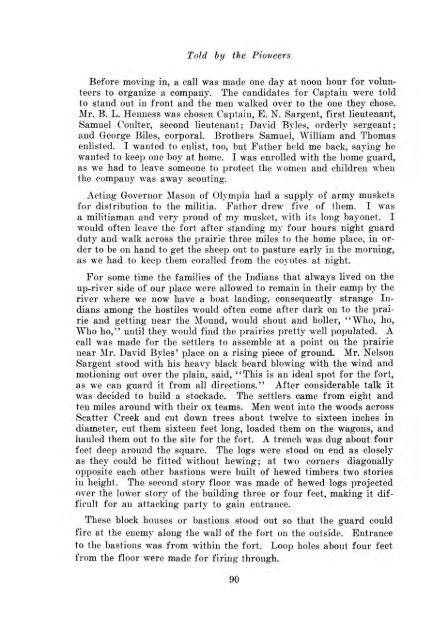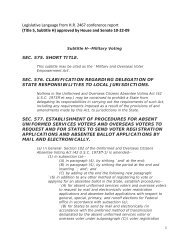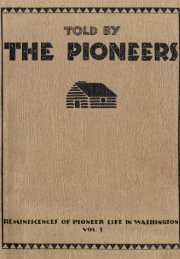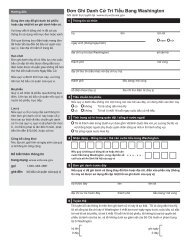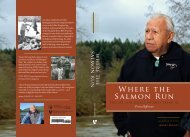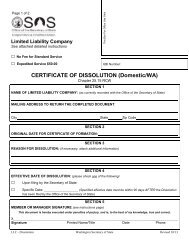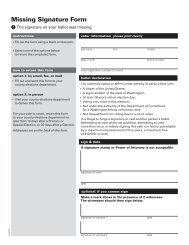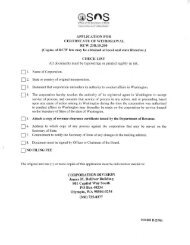Told by the Pioneers - Washington Secretary of State
Told by the Pioneers - Washington Secretary of State
Told by the Pioneers - Washington Secretary of State
Create successful ePaper yourself
Turn your PDF publications into a flip-book with our unique Google optimized e-Paper software.
<strong>Told</strong> <strong>by</strong> <strong>the</strong> Pio11eers<br />
Before mo\-ing in, a call was made one day at noon hour for volunteers<br />
to organize a company. The candidates for Captain were told<br />
to stand out in front and <strong>the</strong> men walked over to <strong>the</strong> one <strong>the</strong>y chose.<br />
Mr. B. L. Henness was chosen Captain, E. N. Sargent, first lieutenant,<br />
Samuel Coulter, second lieutenant; David Byles, orderly sergeant;<br />
and George Biles, corporal. Bro<strong>the</strong>rs Samuel, William and Thomas<br />
enlisted. I wanted to enlist, too, but Fa<strong>the</strong>r held me back, saying he<br />
wanted to keep one boy at home. I was enrolled with <strong>the</strong> home guard,<br />
as we had to leave someone to protect <strong>the</strong> women and children when<br />
<strong>the</strong> company was away scouting.<br />
Acting Governor Mason <strong>of</strong> Olympia had a supply <strong>of</strong> army muskets<br />
for distribution to <strong>the</strong> militia. Fa<strong>the</strong>r drew five <strong>of</strong> <strong>the</strong>m. I was<br />
a militiaman and very proud <strong>of</strong> my musket, with its long bayonet. I<br />
would <strong>of</strong>ten leave <strong>the</strong> fort after standing my four hours night guard<br />
duty and walk across <strong>the</strong> prairie three miles to <strong>the</strong> home place, in order<br />
to be on hand to get <strong>the</strong> sheep out to pasture early in <strong>the</strong> morning,<br />
as we had to keep <strong>the</strong>m cOl'alled from <strong>the</strong> coyotes at night.<br />
For some time <strong>the</strong> families <strong>of</strong> <strong>the</strong> Indians that always lived on <strong>the</strong><br />
up-river side <strong>of</strong> our place were allowed to remain in <strong>the</strong>ir camp <strong>by</strong> <strong>the</strong><br />
river where we now have a boat landing, consequently strange Indians<br />
among <strong>the</strong> hostiles would <strong>of</strong>ten come after dark on to <strong>the</strong> prairie<br />
and getting near <strong>the</strong> Mound, would shout and holler, ""Vho, ho,<br />
"Vho ho," until <strong>the</strong>y would find <strong>the</strong> prairies pretty well populated. A<br />
call was made for <strong>the</strong> settlers to assemble at a point on <strong>the</strong> prairie<br />
near Mr. David Byles' place on a rising piece <strong>of</strong> ground. Mr. Nelson<br />
Sargent stood with his heavy black beard blowing with <strong>the</strong> wind and<br />
motioning out over <strong>the</strong> plain, said, "This is an ideal spot for <strong>the</strong> fort,<br />
as we can guard it from all directions." After considerable talk it<br />
was decided to build a stockade. The settlers came from eight and<br />
ten miles around with <strong>the</strong>ir ox teams. Men went into <strong>the</strong> woods across<br />
Scatter Creek and cut down trees about twelve to sixteen inches in<br />
diameter, cut <strong>the</strong>m sixteen feet long, loaded <strong>the</strong>m on <strong>the</strong> wagons, and<br />
hauled <strong>the</strong>m out to <strong>the</strong> site for <strong>the</strong> fort. A trench was dug about four<br />
feet deep around <strong>the</strong> square. The logs were stood on end as closely<br />
as <strong>the</strong>y could be fitted without hewing; at two corners diagonally<br />
opposite each o<strong>the</strong>r bastions were built <strong>of</strong> hewed timbers two stories<br />
in height. The second story floor was made <strong>of</strong> hewed logs projected<br />
over <strong>the</strong> lower story <strong>of</strong> <strong>the</strong> building three or four feet, making it difficult<br />
for an attacking party to gain entrance.<br />
These block houses or bastions stood out so that <strong>the</strong> guard could<br />
fire at <strong>the</strong> enem~' along <strong>the</strong> wall <strong>of</strong> <strong>the</strong> fort on <strong>the</strong> outside. Entrance<br />
to <strong>the</strong> bastions was from within <strong>the</strong> fort. Loop holes about four feet<br />
from <strong>the</strong> floor were made for firing through.<br />
90


